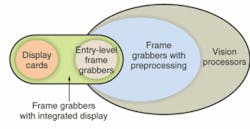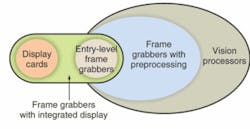Match imaging hardware to specific application needs
Not all frame grabbers are created equal. When purchasing a frame grabber for machine vision or scientific imaging, it helps to be aware of the features common to all imaging hardware.
Imaging hardware can be categorized into three groups. At entry-level are basic frame grabbers that handle the task of acquiring image data from cameras and streaming it into system memory. The next level includes boards with an integrated on-board display. And at the top level are vision processors that combine the functionality of frame grabbers with on-board processors. Hardware at the higher levels has all the capabilities found in the more basic hardware. A typical frame grabber streams image data into system memory for processing, converting it (for analog cameras) from analog to digital.
Entry-level frame grabbers
The entry-level frame grabber for standard color or monochrome analog video like NTSC (National Television System Committee) and and CCIR (International Radio Consultative Committee) may use an off-the-shelf video decoder chip. Considered the backbone of the frame grabber, the video decoder is responsible for the digitization of analog video streams. The NTSC standard in component RGB (red, green, blue), found at a slightly higher level than other entry-level frame grabbers, use discrete analog/digital converters (A/Ds) in addition to the video decoder. Many video decoders have automatic-gain-control (AGC) circuitry, which not only has the potential to alter the captured image, but also can interfere with the performance of image processing algorithms. If the frame grabber is being used for machine vision and its video decoder has AGC, then the AGC should be disabled.
At center are entry-level frame grabbers that acquire data from cameras and stream it into system memory. Increasing one step in complexity leads to higher-performance frame grabbers which feature ASICs that perform preprocessing tasks on the image. At the highest end, are vision processors that combine image acquisition, image processing ASICs, and embedded processors. Outside the diagram on the left are frame grabbers that feature an integrated VGA, and that do not necessarily offer the capabilities of higher-performance frame grabbers.
The effective dynamic range (signal-to-noise ratio or effective number of bits) and pixel jitter are indicators of quality. Analog-to-digital (A/D) converters found on typical frame grabbers offer 8-bit precision, yielding images with 256 gray levels. Greater than 8-bit digitization is available on some frame grabbers, but this is typically a requirement of medical applications; if a greater dynamic range is needed for machine-vision applications, digital cameras are probably a better choice because they are available in several bit depths.
Pixel jitter is related to the quality of the sampling clock that is generated by the phase-locked loop (PLL) or similar device from the video reference signal. To obtain the lowest pixel jitter and most accurate digitization of images, a camera that sends a pixel clock to the frame grabber will usually give the best results.
Measures of performance include the maximum sampling rate or frequency. Higher camera frame rates are achieved using either faster sampling rates or by using multiple camera output readout channels. When working with a camera that outputs video images at 50 frames/s, a frame grabber that can digitize data at roughly 30 MHz is needed. If the camera outputs data on two channels, a frame grabber that can handle multiple channel digitization simultaneously is required; a frame grabber that supports RGB video is a good example. Most frame grabbers permit switching between channels for image capture from different cameras, but if images must be acquired simultaneously from more than one video source, a frame grabber with multiple video decoders will be necessary.
Another important feature of a variable-scan frame grabber is its ability to handle an asynchronous reset operation. This operation refers to the interruption of a camera's exposure and readout cycle, and restarting based on an external event, such as a trigger from a part sensor. When the object of interest is in the camera's field of view, the event informs the frame grabber, which triggers the camera and grabs the frame at that instant.
Increasing complexity
Visualizing the results of an application is often required to calibrate an imaging system and ensure it is running and operational; an on-board display integrated into the frame grabber helps to maintain the performance of the image processing and analysis performed on the image.
Some systems use both a frame grabber and a separate display adapter, which is an acceptable solution for many applications. In such cases, however, the host must support two data streams for live display (one to host memory and one to display memory), which can effectively double the work load on the host system. When the host is burdened with other system functions, less bandwidth and processor time is available. A frame grabber with an integrated display off-loads the host bus from display traffic and frees up a slot. Furthermore, by supporting dual data paths, image data can be transferred to host memory and display memory for simultaneous processing and visualization of image data.
The demands of on-line inspection may exceed the capabilities of a host system. Typical frame grabbers rely on the host for processing, but many applications have high data rates and intensive image processing requirements. Although many newer cameras are designed for very high resolution and frame rates, the host PC may not be able to handle the throughput. In these cases, on-board processing is the answer. Some higher-end frame grabbers are equipped with specialized ASICs that accelerate preprocessing tasks on the image. Vision processors combine image acquisition with custom ASICs and microprocessors on one board to provide a programming flexibility and processing power; however, sufficient I/O is needed to keep processors fed and data moving.
In view of the development of digital interfaces and cameras, some argue that frame grabbers are playing a less significant role in imaging applications. But while traditional frame grabbers convert the analog signals to digital, some type of mechanism is still required to render digital data into a format that image processing software can recognize. Digital frame grabbers serve this purpose. Currently, the most popular digital interfaces are IEEE 1394 and Camera Link.
Camera and frame-grabber technology are intrinsically linked, but before purchasing either, it is important to determine the requirements of the application. When designing a new imaging application from scratch, the designer should consult both frame grabber and camera manufacturers to help choose the best equipment for the actual needs.
SARAH SOOKMAN is a technical writer at Matrox Imaging, 1055 St-Regis, Dorval, Quebec, Canada, H9P 2T4; e-mail: [email protected].

